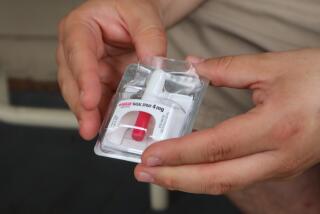Debate Delays Distribution of Anti-Radiation Pills by State
Although California received about 400,000 anti-radiation pills from the federal government last summer, they won’t be distributed until January at the earliest because health officials are still debating how best to get the drugs to the public.
The dispute centers on whether the pills should be given directly to residents who live next to California’s two nuclear power plants or whether they should be placed in hospitals and emergency centers farther away from the plants.
Until the disagreement is resolved, the potassium iodide pills will remain locked away in a Southern California storage facility about an hour away from the San Onofre Nuclear Generation Station and several hours away from the Diablo Canyon power plant in San Luis Obispo County.
Community leaders and antinuclear activists expressed frustration at the delays, saying the pills need to be distributed immediately. At a minimum, they said, state officials ought to move the pills closer to the San Onofre and Diablo Canyon plants while they figure out what to do.
“I’m frustrated by the fact that the process has been so slow,” said Susan Ritschel, a city councilwoman in San Clemente, just north of San Onofre. “It doesn’t seem like it would be that difficult to determine how to get these [pills] distributed to folks.” The state last summer requested the pills from the federal government, which was offering them after the Sept. 11 terrorist attacks. The state said it would provide them to people who live within a 10-mile radius of San Onofre and Diablo Canyon.
The dispute comes down to how best to protect the public, officials say.
Giving the tablets directly to residents would allow people to take a dose right away if an accident occurs, offering the greatest protection against thyroid cancer.
However, officials worry that this could delay evacuations and create a false sense of security. The pills protect against only one type of radioactive isotope -- radioactive iodine.
Also, it would be impossible to distribute the pills in advance to every person who would be working, vacationing or passing through the 10-mile evacuation zones.
These concerns are among the reasons some health officials favor stockpiling the medication at hospitals and other central locations, allowing everyone who is evacuating to pick up a dose once they are safely away from the plant.
“We are continuing to work as fast as we can ... to get a plan finalized and in place so we can move forward,” said Eric Lamoureux, a spokesman for the governor’s Office of Emergency Services.
Dr. Mark Horton, Orange County’s public health officer and a member of the committee deciding on distribution, said: “If we distribute, we certainly want to make that clear that this is not a universal antidote for exposure to any kind of radiation.”
In December, the U.S. Nuclear Regulatory Commission offered potassium iodide pills for roughly 4 1/2 million people who live within 10 miles of a nuclear power plant. As of late October, 17 states had requested the tablets, according to the NRC.
Potassium iodide is a form of salt. If an accident or attack caused a radiation release at San Onofre or Diablo Canyon, people who took a dose would be protected from radioactive iodine being absorbed by their thyroids, which would decrease their risk of thyroid cancer.
Children are particularly susceptible to radiation-induced thyroid cancers, which was the most common ailment suffered after the 1986 Chernobyl nuclear disaster in Ukraine.
The pill does not block the many other forms of radiation released if a reactor were breached, and evacuation would remain paramount.
Lamoureux said he believes a decision will be made well before next summer, which is the federal deadline. Even though the pills are now in storage, he said that they could be quickly moved in case of an emergency.
Antinuclear groups were alarmed by the state’s lack of action. “It’s tragic. Something could happen tomorrow and those pills would not be available to people that need them,” said Daniel Hirsch, director of the Los Angeles-based Committee to Bridge the Gap and former director of the Adlai Stevenson program on nuclear policy at UC Santa Cruz. “I don’t understand why the kids are being held hostage to bureaucratic inertia.”
More to Read
Sign up for Essential California
The most important California stories and recommendations in your inbox every morning.
You may occasionally receive promotional content from the Los Angeles Times.











